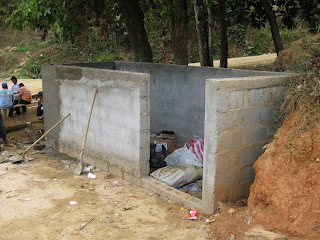Josh and Shannon went to the colonia to look at the water system valves for each distribution zone, and headed back to base at around 1 pm thoroughly baked from the heat - there’s a definite climate change compared to Flagstaff. Mercedes and McWane, in the meantime, went to Coxen Hole to activate another cell phone internet connection and get plastic trash bag for McWane’s solid waste study, and then they spent the remainder of the afternoon trudging around the hills of the colonia to do some mapping of the watershed and enlist some households to participate with the solid waste study.
We had heard of recent efforts to encourage colonia residents to reduce debris, and finally got the opportunity to see these efforts in action. There are several new neighborhood trash collection structures being built of concrete block in various locations that can be reached by the municipal garbage truck each Tuesday. In addition to being more visually appealing, it is hoped that the construction of these structures will reduce the amount of refuse on the ground and in the stream channels.
The other interesting project encourages residents to recycle plastic water and soda bottles to help the construction of a new community multi-use field and ball court located along the entrance road into the colonia. The bottles are filled with sand and then mortared into a wall being built to separate kids and balls from the road. Benches and trash bins will be built the same way. Old tires are being collected, probably to make retaining walls on the slope behind the new field.
Another handwritten sign says 2,567 bottles have been used so far and about 10,000 bottles will be needed to complete the project. Several collection bins like this one below are located throughout the colonia. The attached sign refers to this as the Sandy Bay Recycling Project and asks residents to help build it one bottle at a time.
Mercedes and McWane started on the Monte Frisco side of the colonia and hiked up to the ridge that is between Monte Frisco and Policarpo Galindo. They then hiked the entire ridge of Policarpo Galindo and stopped at the 65000 gallon water tank. They met 2 people that live close to the tank and interviewed them and asked them to participate in the trash collection project. Mercedes and McWane found out that they compost a lot of the food scraps they have left over. Also, much of their trash is burned, because their location is so high up on the hill top. It appears that the location of the people in the colonia can affect the trash disposal practices. After a very pleasant interview, Mercedes and McWane walked back down to the bottom of the colonia, taking the opportunity to talk to a few other people people left and right as they trudged back to the hotel.








No comments:
Post a Comment